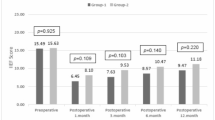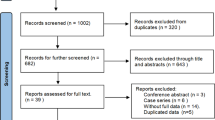Abstract
Background
Digital perioperative programs offer promising solutions to overcome organizational constraints of traditional prehabilitation, potentially improving recovery while reducing healthcare burden and costs. We aimed to assess the impact of adding a surgery-specific module to an optimized digital perioperative program on improving functional outcomes after radical prostatectomy (RP).
Methods
This was a multicentre, prospective, comparative, non-randomized trial including consecutive robot-assisted RP. Intervention was the implementation of the Betty (Better Surgery) coaching program combined with the activation of a RP-specific pre- and rehabilitation module. The primary endpoint was continence recovery, defined as “0 or 1 safety pad per day” at 6 weeks after surgery. Secondary endpoints were mid-term continence, need for postoperative physiotherapy, erectile function, complications, and readmissions.
Results
A total of 177 and 156 RP cases were included in the control and experimental groups. Baseline and pathological variables were statistically comparable between groups. The mean patient age and PSA were 65.3 years and 11 ng/ml, respectively. At 6 weeks after RP, 83.3% of patients following the digital program were continent, as compared with 68.4% in the control group (p = 0.002). The need for postoperative physiotherapy for persistent incontinence was significantly reduced in the digital program group (27.5%, versus 58.8%, p < 0.001). Patients who followed the digital program experienced lower complications although not statistically significant (p = 0.1), unplanned visits (p = 0.025), reoperation rates (p = 0.025), more same-day discharge surgery (p = 0.030), and higher satisfaction (9.4/10 versus 8.3/10, p < 0.001). The main limitation was the absence of randomization.
Conclusions
Besides the benefits provided by the perioperative digital program, the addition of a pre- and rehabilitation module, including surgery-specific content, significantly improved functional recovery after RP and perioperative outcomes.
This is a preview of subscription content, access via your institution
Access options
Subscribe to this journal
Receive 4 print issues and online access
$259.00 per year
only $64.75 per issue
Buy this article
- Purchase on SpringerLink
- Instant access to full article PDF
Prices may be subject to local taxes which are calculated during checkout

Similar content being viewed by others
Data availability
Data is available on reasonable request from the corresponding author.
References
Cornford P, van den Bergh RCN, Briers E, Van den Broeck T, Brunckhorst O, Darraugh J, et al. EAU-EANM-ESTRO-ESUR-ISUP-SIOG guidelines on prostate cancer-2024 update. Part I: screening, diagnosis, and local treatment with curative intent. Eur Urol. 2024;86:148–63.
Hoffman KE, Penson DF, Zhao Z, Huang LC, Conwill R, Laviana AA, et al. Patient-reported outcomes through 5 years for active surveillance, surgery, brachytherapy, or external beam radiation with or without androgen deprivation therapy for localized prostate cancer. JAMA. 2020;323:149–63.
Donovan JL, Hamdy FC, Lane JA, Young GJ, Metcalfe C, Walsh EI, et al. Patient-reported outcomes 12 years after localized prostate cancer treatment. NEJM Evid. 2023;2:EVIDoa2300018.
Lardas M, Grivas N, Debray TPA, Zattoni F, Berridge C, Cumberbatch M, et al. Patient- and tumour-related prognostic factors for urinary incontinence after radical prostatectomy for nonmetastatic prostate cancer: a systematic review and meta-analysis. Eur Urol Focus. 2022;8:674–89.
Van den Broeck T, Oprea-Lager D, Moris L, Kailavasan M, Briers E, Cornford P, et al. A systematic review of the impact of surgeon and hospital caseload volume on oncological and nononcological outcomes after radical prostatectomy for nonmetastatic prostate cancer. Eur Urol. 2021;80:531–45.
Iacovelli V, Carilli M, Sandri M, Forte V, Cipriani C, Bertolo R, et al. The role of preoperative prostatic shape in the recovery of urinary continence after robotic radical prostatectomy: a single cohort analysis. Prostate Cancer Prostatic Dis. 2023;26:374–378.
Rahota RG, Salin A, Gautier JR, Almeras C, Garnault V, Tollon C, et al. A prehabilitation programme implemented before robot-assisted radical prostatectomy improves peri-operative outcomes and continence recovery. BJU Int. 2022;130:357–63.
Mungovan SF, Carlsson SV, Gass GC, Graham PL, Sandhu JS, Akin O, et al. Preoperative exercise interventions to optimize continence outcomes following radical prostatectomy. Nat Rev Urol. 2021;18:259–81.
Azhar RA, Bochner B, Catto J, Goh AC, Kelly J, Patel HD, et al. Enhanced recovery after urological surgery: a contemporary systematic review of outcomes, key elements, and research needs. Eur Urol. 2016;70:176–87.
Molenaar CJ, van Rooijen SJ, Fokkenrood HJ, Roumen RM, Janssen L, Slooter GD. Prehabilitation versus no prehabilitation to improve functional capacity, reduce postoperative complications and improve quality of life in colorectal cancer surgery. Cochrane Database Syst Rev. 2023;5:CD013259.
Ploussard G, Kesch C, Calleris G, Buhas B, Salin A, Almeras C, et al. From an on-site program to a mobile app for prehabilitation and rehabilitation for robotic radical prostatectomy: lessons learned from 5 years of experience, the COVID-19 outbreak, and comparison with nationwide data. Eur Urol Oncol. 2023:297–9.
Schnitzbauer AA, Zmuc D, Fleckenstein J. Digital prehabilitation-a solution to resource shortages?. Lancet Digit Health. 2024;6:e11.
den Bakker CM, Schaafsma FG, Consten ECJ, Schraffordt Koops SE, van der Meij E, van de Ven PM, et al. Personalised electronic health programme for recovery after major abdominal surgery: a multicentre, single-blind, randomised, placebo-controlled trial. Lancet Digit Health. 2023;5:e485–94.
Temple-Oberle C, Yakaback S, Webb C, Assadzadeh GE, Nelson G. Effect of smartphone app postoperative home monitoring after oncologic surgery on quality of recovery: a randomized clinical trial. JAMA Surg. 2023;158:693–9.
van Ede ES, Scheerhoorn J, Buise MP, Bouwman RA, Nienhuijs SW. Telemonitoring for perioperative care of outpatient bariatric surgery: Preference-based randomized clinical trial. PLoS ONE. 2023;18:e0281992.
Grygorian A, Montano D, Shojaa M, Ferencak M, Schmitz N. Digital health interventions and patient safety in abdominal surgery: a systematic review and meta-analysis. JAMA Netw Open. 2024;7:e248555.
d’Agate D, Martini A, Lesourd M, Tollon C, Loison G, Almeras C, et al. Patient experience and satisfaction after same-day discharge radical prostatectomy using a personalized, digital perioperative programme. World J Urol. 2024;42:378.
Martini A, Kesch C, Touzani A, Calleris G, Buhas B, Abou-Zahr R, et al. Personalized mobile app-based program for preparation and recovery after radical prostatectomy: initial evidence for improved outcomes from a prospective nonrandomized study. J Med Internet Res. 2024;26:e55429.
Uleri A, Baboudjian M, Pasticier G, Basset V, Cordier G, Malavaud B, et al. Personalized digital, multilevel program for preparation and early recovery after urologic surgery: a prospective, multicenter, pre- and postintervention trial. Eur Urol Focus. 2025;S2405-4569:00045–8.
Clavien PA, Barkun J, de Oliveira ML, Vauthey JN, Dindo D, Schulick RD, et al. The Clavien-Dindo classification of surgical complications: five-year experience. Ann Surg. 2009;250:187–96.
Briggs LG, Reitblat C, Bain PA, Parke S, Lam NY, Wright J, et al. Prehabilitation exercise before urologic cancer surgery: a systematic and interdisciplinary review. Eur Urol. 2022;81:157–67.
Reynolds BR, Bulsara C, Zeps N, Codde J, Lawrentschuk N, Bolton D, et al. Exploring pathways towards improving patient experience of robot-assisted radical prostatectomy (RARP): assessing patient satisfaction and attitudes. BJU Int. 2018;121:33–9.
Liu X, Yang G, Xie W, Lu W, Liu G, Xiao W, et al. Efficacy of telerehabilitation for total knee arthroplasty: a meta-analysis based on randomized controlled trials combined with a bibliometric study. J Orthop Surg Res. 2024;19:874.
Lonner JH, Naidu-Helm A, Van Andel D, Anderson MB, Ditto R, Redfern RE, et al. Smartphone-based care platform versus traditional care in primary knee arthroplasty in the United States: cost analysis. JMIR Mhealth Uhealth. 2025;13:e46047.
Haack M, Fischer ND, Frey L, Sparwasser P, Dotzauer R, Duwe G, et al. Digital informed consent for urological surgery - randomized controlled study comparing multimedia-supported vs. traditional paper-based informed consent concerning satisfaction, anxiety, information gain and time efficiency. Prostate Cancer Prostatic Dis. 2024;27:715–19.
Goode PS, Johnson TM 2nd, Newman DK, Vaughan CP, Echt KV, Markland AD, et al. Perioperative mobile telehealth program for post-prostatectomy incontinence: a randomized clinical trial. J Urol. 2022;208:379–87.
Wennerberg C, Hellstrom A, Schildmeijer K, Ekstedt M. Effects of web-based and mobile self-care support in addition to standard care in patients after radical prostatectomy: randomized controlled trial. JMIR Cancer. 2023;9:e44320.
Ploussard G, Almeras C, Beauval JB, Gautier JR, Garnault V, Fremont N, et al. A combination of enhanced recovery after surgery and prehabilitation pathways improves perioperative outcomes and costs for robotic radical prostatectomy. Cancer. 2020;126:4148–55.
Orecchia L, Mjaess G, Albisinni S. Setting new standards: robot-assisted radical prostatectomy as a day case. Prostate Cancer Prostatic Dis. 2025;28:351–354.
Riviere C, Brureau L, Parnot C, Becherirat S, Duverger C, Picchi H, et al. Effectiveness of a digital telemonitoring platform for cancer care of older patients: the connectelderlypatienttodoctor study. Int J Cancer. 2023;152:504–10.
Rosa C, Campbell AN, Miele GM, Brunner M, Winstanley EL. Using e-technologies in clinical trials. Contemp Clin Trials. 2015;45:41–54.
Acknowledgements
Association Française d’Urologie for its support.
Author information
Authors and Affiliations
Contributions
AU: Project development, data collection, data analysis, and manuscript drafting; EP: data collection, critical revision of the manuscript; NM: data collection, critical revision of the manuscript; GP: data collection, critical revision of the manuscript; AM: data collection, critical revision of the manuscript; ND: data collection, critical revision of the manuscript; NSV: data collection, critical revision of the manuscript; GG: data collection, critical revision of the manuscript; BP: data collection, critical revision of the manuscript; LM: data collection, critical revision of the manuscript; BM: data collection, critical revision of the manuscript; MB: data collection, critical revision of the manuscript; JBB: data collection, critical revision of the manuscript; JR: data collection, critical revision of the manuscript; LB: data collection, critical revision of the manuscript; GP: project development, critical revision of the manuscript; CD: project development, critical revision of the manuscript; ADLT: project development, critical revision of the manuscript.
Corresponding author
Ethics declarations
Competing interests
Jean-Baptiste Beauval and Guillaume Ploussard have ownership in AIMED2 company.
Ethical approval
This study was approved by the local ethics committee of the Croix du Sud hospital and was conducted in line with the principles of the Declaration of Helsinki and nformed consent have been obtained.
Additional information
Publisher’s note Springer Nature remains neutral with regard to jurisdictional claims in published maps and institutional affiliations.
Supplementary information
Rights and permissions
Springer Nature or its licensor (e.g. a society or other partner) holds exclusive rights to this article under a publishing agreement with the author(s) or other rightsholder(s); author self-archiving of the accepted manuscript version of this article is solely governed by the terms of such publishing agreement and applicable law.
About this article
Cite this article
Uleri, A., Potiron, E., Miaadi, N. et al. Addition of a surgery-specific module to a perioperative, telemedicine program for improving functional outcomes after radical prostatectomy: a prospective, multicenter, non-randomized study. Prostate Cancer Prostatic Dis (2025). https://doi.org/10.1038/s41391-025-01026-y
Received:
Revised:
Accepted:
Published:
DOI: https://doi.org/10.1038/s41391-025-01026-y



